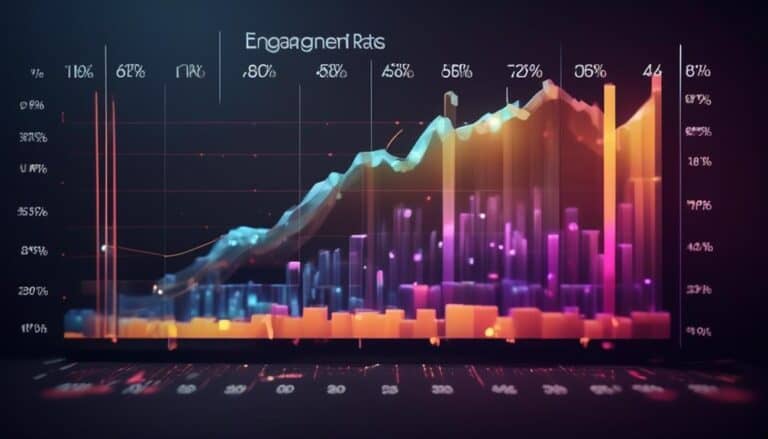Decoding Data: Tools and Techniques for Measuring Content Marketing Success
As a marketing professional navigating through the vast sea of digital content, you know that understanding the currents beneath the surface is crucial for steering your ship in the right direction.
Decoding data in the realm of content marketing can be likened to the compass guiding your strategic voyage.
With an array of tools and techniques at your disposal, each wave of information presents an opportunity to refine your course towards success.
In a landscape where metrics reign supreme, uncovering the insights hidden within the data can mean the difference between lost at sea or charting a course towards the treasure trove of content marketing effectiveness.
Key Takeaways
- Utilize advanced data analytics tools for measuring content performance
- Monitor keyword rankings and website traffic for content optimization
- Assess audience engagement through social media metrics
- Measure email campaign effectiveness through open rates and click-through rates
Data Analytics Tools

To effectively measure the success of your content marketing efforts, utilizing advanced data analytics tools is imperative. Data visualization plays a crucial role in transforming complex data sets into easily understandable visuals. By leveraging data visualization techniques, you can gain valuable insights into how your content is performing across various channels and audience segments. These visual representations allow for quick identification of trends, patterns, and outliers, enabling you to make data-driven decisions to optimize your content strategy.
In addition to data visualization, A/B testing techniques are essential for refining your content marketing approach. By systematically testing different variables such as headlines, visuals, or call-to-action buttons, you can determine what resonates best with your audience. A/B testing provides empirical evidence to support your content decisions, ensuring that you're continuously improving and adapting based on real-time feedback. Incorporating A/B testing into your content marketing strategy empowers you to enhance engagement, conversion rates, and overall performance.
SEO Metrics Analysis
Utilize advanced SEO metrics analysis to gauge the effectiveness of your content marketing strategies and enhance online visibility. By diving deep into the data, you can uncover valuable insights that will help you optimize your content for better performance.
Here are five key elements to consider:
- Keyword Rankings: Monitor how your content is ranking for relevant keywords to understand its impact on search engine results.
- Website Traffic: Analyze the traffic coming to your site and identify which content pieces are driving the most visitors.
- Click-Through Rates: Evaluate the CTR of your content in search engine results pages to determine its effectiveness in attracting clicks.
- Bounce Rates: Examine the bounce rates of your pages to assess how engaging your content is to visitors.
- Conversion Rates: Track the conversion rates of your content to see how effectively it's driving desired actions from your audience.
Social Media Tracking

By applying a strategic approach to measuring the impact of your content marketing efforts on social media platforms, you can gain valuable insights into audience engagement and reach. Social media tracking involves monitoring key metrics to evaluate the effectiveness of your content strategy.
Engagement tracking allows you to assess how your audience interacts with your posts, including likes, shares, comments, and click-through rates. By analyzing these metrics, you can determine which content resonates most with your followers and tailor future posts accordingly.
Additionally, social media tracking provides valuable audience insights that can inform your content creation process. By understanding the demographics, interests, and behaviors of your followers, you can create targeted and relevant content that drives engagement and builds brand loyalty. Utilizing tools like social media analytics platforms can help streamline this process and provide you with real-time data to make informed decisions about your content strategy.
Email Campaign Metrics
When analyzing the performance of your email campaigns, focusing on specific metrics is essential to gauging their effectiveness and optimizing future strategies. To ensure your email campaigns are on track, consider the following key metrics:
- Open Rate Analysis: Measure the percentage of recipients who open your email. This metric provides insights into the effectiveness of your subject lines and sender name.
- Click-Through Rate Evaluation: Evaluate the percentage of recipients who clicked on links within your email. This metric indicates the relevance and engagement level of your content.
- Conversion Rate Tracking: Monitor the percentage of recipients who completed a desired action after clicking on a link in your email. This metric helps determine the effectiveness of your call-to-action.
- Bounce Rate Examination: Analyze the percentage of emails that weren't successfully delivered to recipients' inboxes. High bounce rates may indicate issues with your email list quality.
- Unsubscribe Rate Review: Keep track of the percentage of recipients who opted out of receiving further emails. Monitoring this metric can help you refine your targeting and content strategies for better engagement.
Conversion Rate Optimization

To enhance the effectiveness of your email campaigns, optimizing the conversion rate is crucial for achieving desired outcomes and maximizing ROI. A/B testing and landing page optimization are key strategies to improve conversion rates. A/B testing involves comparing two versions of a webpage to see which one performs better, allowing you to make data-driven decisions. Landing page optimization focuses on creating compelling and user-friendly landing pages to increase conversions. By continuously testing and refining your strategies, you can identify what resonates best with your audience and drives conversions. Utilizing analytics tools to track user behavior and engagement can provide valuable insights for further optimization. Remember, conversion rate optimization is an ongoing process that requires experimentation and adaptation to ensure your email campaigns are consistently driving results.
| A/B Testing | Landing Page Optimization |
|---|---|
| Compare two versions to determine effectiveness | Create user-friendly and compelling landing pages |
| Data-driven decision-making | Increase conversions |
| Experiment with different elements | Continuously refine strategies |
Frequently Asked Questions
How Can Content Marketing Success Be Measured in Terms of Brand Recognition and Sentiment Analysis?
To measure content marketing success in terms of brand recognition and sentiment, analyze brand sentiment through customer feedback and sentiment analysis tools. Track engagement metrics like social shares, comments, and time spent on content to gauge audience perception and emotional response accurately.
What Are Some Key Indicators to Look for When Analyzing the Effectiveness of Influencer Partnerships in Content Marketing?
When analyzing influencer partnerships in content marketing, look for key indicators. Focus on engagement rates and conversion rates to measure effectiveness. Evaluate influencer authenticity and audience demographics to ensure alignment with your brand's goals and target audience.
How Can A/B Testing Be Utilized to Improve Content Marketing Strategies and Measure Success?
Utilize A/B testing to enhance content marketing strategies. Test different content variations to analyze user behavior. Compare conversion rates and engagement rates to measure success. Experimentation is key to optimizing your approach and achieving better results.
Are There Any Emerging Trends in Data Analytics That Could Potentially Revolutionize Content Marketing Measurement Techniques?
Explore emerging trends in data analytics for revolutionary content marketing measurement. Machine learning applications and predictive analytics offer advanced insights. Utilize data visualization and storytelling techniques to convey complex metrics effectively for enhanced strategy development.
How Can Customer Journey Mapping Be Incorporated Into Data Analysis to Better Understand the Impact of Content Marketing on the Overall Customer Experience?
To better understand customer engagement and user behavior, incorporate customer journey mapping into data analysis. This method provides a comprehensive view of interactions, enabling a deeper understanding of content marketing's impact on the overall customer experience.
Conclusion
In conclusion, by utilizing data analytics tools, conducting thorough SEO metrics analysis, tracking social media engagement, monitoring email campaign metrics, and optimizing conversion rates, you can effectively measure the success of your content marketing efforts.
These tools and techniques provide valuable insights into the performance of your content, helping you make informed decisions and refine your strategies for maximum impact and ROI.
Stay diligent in your data analysis efforts to continuously improve and enhance your content marketing success.








